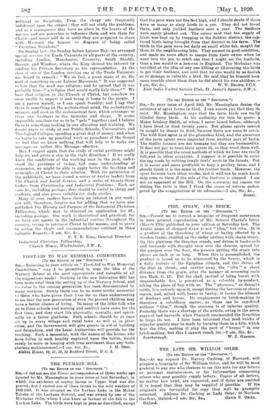PISE, STRAW, AND BRICE.
[To THE ED/TOR OF THE " SPECTATOR.")
SIR,—Permit me to correct a misprint of frequent occurrence in your printed reproduction of Mr. Somers Clarke's letter (March 17th) published in your edition of Saturday last. The Arabic name of chopped straw is not " tibu," but tibn. It is a product of the thrashing of wheat or barley effected by a wooden frame, studded on the under surface with sharp stones. On this platform the thrasher stands, and drives it backwards and forwards with draught oxen over the sheaves, spread for the purpose over the floor, the process cutting the straw into pieces an inch or so long. When this is accomplished, the product is tossed up to be winnowed by the breeze, which is a daily feature of the Egyptian climate, and this drives off the dust in clouds, and carries away the "tibn " a short distance from the grain, after the manner of screening coals (see Matt. -ii. 12). But the chaff, instead of being burnt with unquenchable fire, is preserved as a valuable by-product, taking the place of hay with us. The " ghamoos," or draught cattle, live entirely upon it, except during the berseeni or-clover season, and, mixed with beans or barley, it forms the aliment of donkeys and horses. Its employment in brick-making is therefore a subsidiary matter, as these can be gun-dried without "tibn," though the outcome is of inferior quality. Probably there was a shortage of the article, owing to the seven years 'of bad harvests, when Pharaoh commanded the Israelites to forgo its use. I have been informed that mud bricks of superior quality may be made by burning them in 'it kiln, which fires the tibn, making it play the part of "breeze" in oar brick-making, bat this I cannot vouch for.—I am, Sir, &e.,


































 Previous page
Previous page